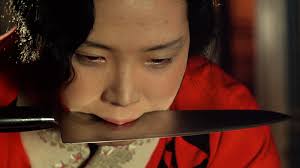Eye For Film >> Movies >> In The Realm Of The Senses (1976) Film Review

Prolific Japanese director Nagisa Oshima's notorious 1976 study of dangerous deviance remains a powerful and shocking experience. Inspired by true events, the film serves as a cautionary fable detailing the fallout of a country's traditional reserve, Oshima taking a matter-of-fact approach to some potentially gratuitous subject matter. It's an obvious precursor to the assaultive cinema of modern auteurs such as Catherine Breillat and Lars von Trier, but even today it makes the likes of Antichrist look like a bible story, Oshima's subtle edge making the escalating erotic experimentation insidiously disturbing.
As war looms again in 1936, a Tokyo prostitute who has moved on to maid work finds herself becoming sexually obsessed with her womanising boss. Despite - or perhaps because of - both of them having spouses, their torrid affair becomes all-encompassing, their love-making even taking place in full view of the public. However, Sada's attachment to the virulent Ishida grows increasingly violent and threatening; it soon becomes clear that his submission to her twisted whims could cost him his life.

Opening with a telling instance of one prostitute with lesbian tendencies objectifying and molesting the markedly beautiful Sada, Oshima's tale takes place almost exclusively in faceless and repressive bourgeois hotel bedrooms, the characters' cocoon-like relationship growing ever more claustrophobic. Traditional performance mingles with their unabashed sensuality, as inhibition-free geisha girls and musicians drop in and occasionally reflect on the situation, Sada even singing and playing instruments at Ishida's request to disguise their concurrent copulation.
Significantly, Sada's beauty is established as a burden; she seems naively resigned to pleasing those who praise her, as we see her attempt to do in almost charitable fashion with an admiring old homeless man at the start. Her antics are effectively juxtaposed with the period surroundings, while society in general is seen to be fixated on sexuality in a way that exposes the traditional notion of Japanese reserve as both contradictory to and symptomatic of a pervasive underlying promiscuity.
Oshida's frank approach to documenting his characters' sexual exploration keeps events from descending into mere attention-grabbing titillation, his careful camerawork getting uncomfortably close at some points and keeping a sobering distance at others in a way that provokes and compels but never attempts to arouse. The somber, doom-laden score using traditional native instruments also adds to the atmosphere of unease.
The couple's relationship shifts on unsettling gender dynamics - one arresting moment shows Ishida to have a comfortable attitude towards Sada's menstrual blood that makes comparable scenes in the body-horror opus Anatomy Of Hell seem ridiculously desperate. While it is Ishida that initiates the affair, it's Sada who increasingly takes control, leading him to even ponder who his penis belongs to, to which she responds by saying it is now hers. His member is constantly referred to as 'it', while his appreciation of her attributes highlights that their bodies are almost something other than their own, their lust a force beyond their comprehension that they are trying to conquer. Sada's lack of fulfillment with her ageing husband fuels her desires, then guilt makes her masochistic, but it's jealousy and paranoia that eventually makes both her and her lover monsters, taking their destructive urges out on each other and even innocent bystanders.
Tatsuya Fuji is nude for most of the duration but always communicates more than just Ishida's libido, while Eiko Matsuda is memorably unhinged but also sympathetically vulnerable in her hopeless longing. Despite all the outrageous and mostly un-simulated activity, there is a real sensuality to the couple's contact, as well as a sad undertow to their sadistic influence upon each other.
Playful moments of shared humour and mutual tenderness also help to make the pair's bond believable, Oshida achieving an intimacy that's echoed by modern libertine directors such as John Cameron Mitchell and Larry Clark, with the bracingly explicit but wonderfully perceptive Shortbus and Ken Park respectively. The excesses of the flesh on display here breach taboos in fearless fashion, but there is purpose and ambiguity to the exponentially kinky and troubling encounters that could go unnoticed by the easily offended, while others will just find the story repetitive and perverse.
A natural progression from Oshida's earlier Violence At High Noon as well as the notable femme fatale-fixated classics Onibaba and Irezumi, the film has also been a big influence on the apocalyptic debauchery of Lukas Moodysson's lacerating A Hole In My Heart.
It stands as a haunting and transfixing work in its own right, every bit as powerful today as it no doubt was upon release, especially now that the BBFC have deigned the film fit for audience consumption completely uncensored. In The Realm Of The Senses is a deceptively layered and extremely engrossing transgressive treat for those who can handle its unapologetic portrayal of primal passion and lethal infatuation.
Reviewed on: 18 Oct 2011


















